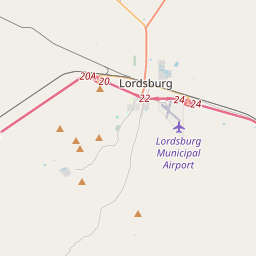Women of Shakespeare: Emma Marble Muir (1873–1959), Rita Wells Hill (1901–1985), Janaloo Hill Hough (1939–2005)
Historical marker location:






Emma Marble Muir arrived at the mining town of Shakespeare in 1882. She and her daughter, Rita Wells Muir, learned to appreciate and preserve the town’s history. Rita and her husband bought Shakespeare as part of their ranch in 1935. Rita passed the ranch to her daughter, Janaloo Hill Hough. Janaloo and her husband continued fighting for the history and preservation of Shakespeare. Investing their own resources, they rebuilt some of the buildings destroyed by a fire in 1997. Without the dedication of this mother, daughter and granddaughter, the ghost town of Shakespeare would not exist today
The Historic Women Marker Initiative of 2007 captured the public’s imagination. It has received international attention for its ambitious goal of telling women’s history in New Mexico on some of the state’s 650 Official Scenic Historic Markers. Before 2007, perhaps three markers mentioned women at all.
The lives of the only known female Buffalo solider, one of the world’s most famous artists, and unsung heroes like Sally Rooke who gave her life at her switchboard warning Folsom’s citizens of a wall of water approaching their town are honored on 75 women’s history markers.
The first phase of the Initiative concluded in 2010. Ten more markers were installed in 2015 and an additional 25 are expected to bring their numbers to an even 100 in the coming years. The program is a partnership of the New Mexico Women’s Forum, HPD, CPRC, New Mexico Department of Transportation, and the public. The 2006 legislature made the initial 65 historic markers possible.
Like all state historic markers, the women’s history markers are designed in the Park Service Rustic style adopted when the program began in 1935. What’s different is their perspective of New Mexico history.
New Mexico was one of the last territories to become a state, gaining statehood in 1912. Before that, it had been part of the Spanish Empire, Mexico, and the United States Territory of New Mexico.
In the 16th and 17th centuries, Spanish settlers began to establish missions and settlements in the area that is now Hidalgo County. These settlers were primarily seeking mineral wealth, especially silver, and also aimed to bring Christianity to the Native American population. However, conflicts between the settlers and Native Americans were frequent, as the Spanish sought to assert control over the region.
Throughout the 19th century, Hidalgo County experienced various changes in ownership and territorial boundaries. At the beginning of the century, it was part of Spain's New Spain colony, then became part of Mexico after gaining independence in 1821. When the United States acquired the land through the Treaty of Guadalupe Hidalgo in 1848, Hidalgo County became part of the New Mexico Territory.
The 20th century brought further development and growth to Hidalgo County. The arrival of the railroad in the early 1900s played a significant role in supporting the local economy, as it facilitated the transportation of livestock and goods. Agriculture, particularly livestock rearing and ranching, became the primary industry. Today, Hidalgo County continues to thrive as a rural area with a strong agricultural base, while also embracing the preservation of its unique cultural heritage.
Hidalgo County Timeline
This timeline provides a concise overview of the key events in the history of Hidalgo County, New Mexico.
- Created in 1919 by an act of the New Mexico Legislature.
- Named after Miguel Hidalgo y Costilla, a Mexican priest who played a significant role in the Mexican War of Independence.
- In the late 1800s, the area was primarily a ranching community.
- In 1910, the Butterfield Overland Mail route was extended through Hidalgo County, bringing increased transportation and trade to the region.
- In the early 1900s, mining became an important industry in Hidalgo County, with silver, lead, and zinc being the main minerals extracted.
- The town of Lordsburg, located in Hidalgo County, became a major hub for transportation and trade due to its location along the Southern Pacific Railroad.
- In the mid-1900s, the area saw a decline in mining and an increase in agriculture, with ranching and farming becoming the primary economic activities.
- Hidalgo County experienced population growth in the late 20th century, mainly due to retirees and individuals seeking a rural lifestyle.
- The county remains primarily rural today, with a focus on agriculture, tourism, and outdoor recreational activities.